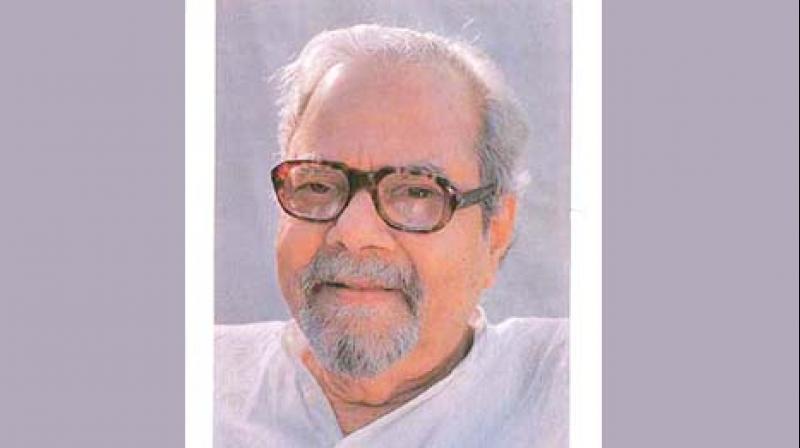Philosophy moderates dynamics of religions

Chennai: What we usually associate with ‘religious emotions’ of people come as a mixed bag. Just few days ago, it was with shock and awe that one read about 17-year-old Varshil Shah of Surat, after having scored 98.99 percentile in the recent 12th class Gujarat Higher Secondary Board exam, tonsuring his head to become a Jain monk.
Such sudden and radical combinations of plentitude and asceticism are rare in the modern world, and that too at such a young age. Nearer home, it reminds one of how the late Kanchi Parmacharya, Sri Chandrasekharendra Saraswathi, known as Swaminathan as a Villupuram boy, at the tender age of 13, was suddenly bestowed with the onerous task of having to take ‘sanyas’ and to ascend the pontifical seat of the Kanchi Kamakoti Mutt.
It is such shakeup or makeover moments in people’s lives that bring into focus the staggering depth, breath and diversity of religious phenomenon – whether Eastern or Western. It is when one wishes to make sense of actions that go under the rubric of religion, from rites, rituals, ceremonies, myths and the belief systems that support them. In modern social anthropology this continues to be a huge area of engagement in itself.
This piece seeks to amplify some of the views discussed on the issue in these columns recently, particularly the idea how religions and philosophy of religions need to be seen as complementing each other, more so to keep cultural plurality and freedoms alive. To avert what scholars term ‘monopolisation of truth’ and oppressive social structures that flow from it, philosophies of religion that keep dialogues open-ended are the best bet.
Given the texture of religious phenomena, as it unwound through history, they have both these phases of ‘fusion’ and ‘fission’, fluctuating from time to time. As ‘fusion’, religion helps to “bridge differences” among individuals, giving all of them a foothold to participate in the ‘journey of souls’ in terms of a metaphysic, it seeks to expound and defend. In its ‘fission’ mode, as in nuclear reactor, religion can be disruptive and chaotic.
Too much of emphasis on rituals and ceremonies could lead to cynicism among religious practitioners, particularly when the several hats they don are seen as discriminatory. They could trigger a backlash when religion as ‘fusion’ could turn into a ‘fission’ mode. And when various, diverse, atomic groups are sought to be aggregated under an all-embracing singular belief, the yearnings for ‘fusion’ by religious authorities could get too rigid and distort the spirit of all that is noble in religions, namely to mitigate human suffering.
It is thus at every step, religion needs to go hand-in-hand with philosophy of religion, the latter serving as ‘moderators’ or ‘coolants’ as in a reactor, providing the secular space for deeper reflections and discussions. In fact, looking at the wider canvas of the India’s intellectual traditions, to swim through a perspective articulated by the late, distinguished contemporary Indian Philosopher, Daya Krishna, the so-called ‘orthodoxy versus heterodoxy’ binary division of ‘Classical Indian Schools of Thought’ hardly capture the play of their richness, variety and complexity that have sustained Indian civilisation.
It is in a series of amazingly original and brilliant collection of even-handedly critical essays written over a ‘long period of time’ and published under the title ‘Indian Philosophy – A Counter Perspective’, Prof. Daya Krishna has pointed out that, “History is always the story of change, development, differentiation and innovation….There is no such thing as final, frozen positions, which the term ‘school’ in the context of Indian philosophy, usually connote. If ‘schools’ change, develop, differentiate and divide, then they are never closed, finished or final with respect to what they are trying to say. There could, then, be no fixed body of Nyaya, Vaisesika, Saamkhya, Mimaamsa, Vedanta, Buddhist, Jain or Caarvaaka positions except in a minimal sense.”
Prof Daya Krishna, turning his back to a “dead, mummified picture of Indian philosophy”, as he put it, was to remind us that India’s intellectual traditions, to have contemporary relevance, are better seen as continuously churning philosophical perspectives.
Transposing that line of thought, India’s religious traditions, from the highest forms of intuiting the ultimate ‘Brahman’, to the most mundane forms of snake and tree worship, have all implicitly co-existed as philosophies of religion too; for each one, however small, had a counter-perspective on the table, to the ‘darshana’ or vision that went before it. And they cannot all be fitted into one archetypal, rigid, nationalistic perspective, as today’s ideologue Hindu hardliners would want to suggest.
In this backdrop, by far the best philosophical appreciation and placing in context of the great Vaishnavite saint and social reformer, Sri Ramanuja, in his millennial year that culminated with celebrations in May 2017, has come in a little noticed annual calendar-cum-almanac published as a ‘dedication’ to the saint by Sri Krishna Sabha of Mumbai.
The Sabha, in its brilliant introduction on Ramanuja’s contributions in propounding the ‘Vishishtadvaita’ philosophy, says it needs to be seen in the background “in which it was born”, as it went beyond ‘Advaita’ as propounded by Adi Sankara. After all, Sankara “was also an intellectual giant,” says the publication.
But ‘Advaita’ with its ‘doctrine of illusion (Mayavaad), was still seen as a halfway house between the ‘Vedic religion’ and ‘Buddhism’, that Ramanuja dared to go back to the foundations of the ‘Upanishads’ to show that the world is really real, paving way for more compassionate and inclusive religious practices later by incorporating the Tamil ‘Prabandham’ tradition as well. This is yet another standing example of how religions and philosophy of religions have always been complementary in the Indian context and the last word is never said.

